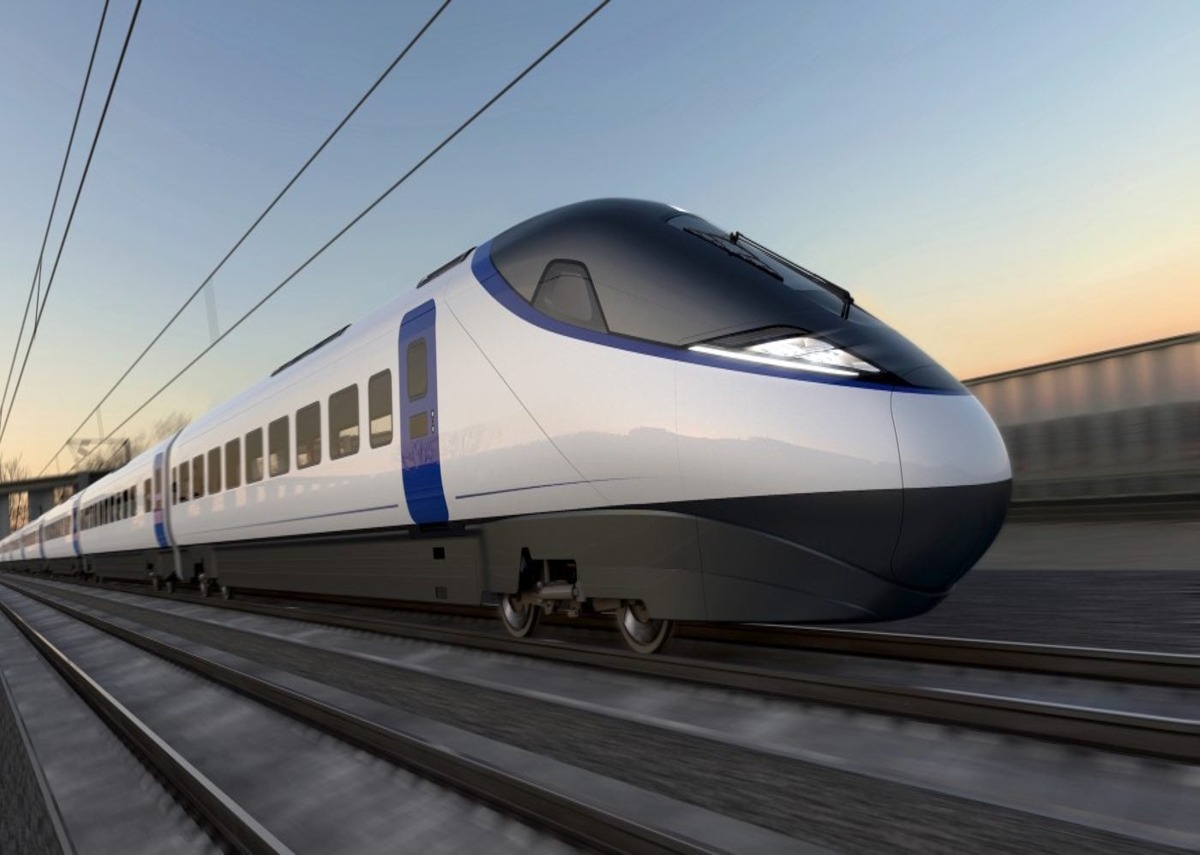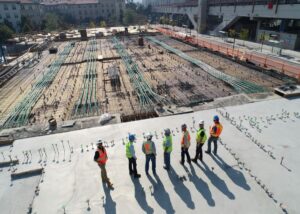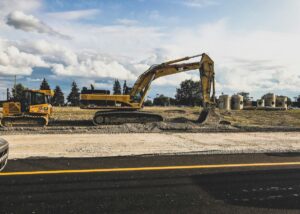The article ‘Pioneering the Future: Exploring Cutting-Edge High-Speed Rail Innovations’ delves into the latest advancements in high-speed rail technology and infrastructure. It examines the blend of speed, sustainability, digital integration, engineering marvels, and intermodal connectivity that are shaping the future of rail transportation. The piece highlights how these innovations are not only revolutionizing travel but also fostering a more sustainable and interconnected world.
Table of Contents
Key Takeaways
- Maglev technology and the Shinkansen exemplify the pinnacle of high-speed rail innovation, with the U.S. also advancing in magnetic levitation transportation.
- Sustainability is a core component of modern rail systems, with hydrogen fuel and eco-friendly construction practices leading the way.
- Digitalisation and advanced safety technologies are transforming rail communication and significantly enhancing accident prevention.
- Engineering challenges such as tunnels, bridges, and geotechnical issues are being overcome with cutting-edge solutions, pushing the boundaries of what’s possible in rail infrastructure.
- The integration of rail with multimodal transport systems is creating a seamless transportation tapestry that supports the strategic evolution of international trade.
Zooming into the Future: Maglev and Beyond
The Quest for High-Speed Rail in the U.S.
The dream of zipping across the country at unprecedented speeds has long captured the American imagination. Maglev technology, with its promise of frictionless travel and lightning-fast commutes, stands at the forefront of this vision. Yet, despite the buzz, the U.S. is still playing catch-up with its global counterparts in bringing these futuristic trains to life.
While there have been strides in research and proposals for high-speed corridors, the actual implementation of a commercial Maglev system remains a work in progress. The potential benefits are clear: a leap forward in efficiency, a reduction in travel times, and a much-needed boost to sustainable transportation. But the journey from concept to reality is fraught with challenges, from securing funding to navigating complex regulatory landscapes.
The quest for high-speed rail in the U.S. is more than just a technological challenge; it’s a test of national will and vision.
Here’s a snapshot of the current state of play:
- Ongoing research into Maglev capabilities
- Several proposed Maglev projects across the country
- Intense discussions on the feasibility and impact of high-speed rail
Japan’s Trailblazing Shinkansen and Maglev Trains
When it comes to high-speed rail, Japan is nothing short of a superstar. The Shinkansen, or bullet train, has become synonymous with speed and efficiency, zipping across the country and shrinking travel times dramatically. But the real game-changer might just be the Maglev train. With magnetic levitation technology, this train isn’t just fast—it’s futuristic, floating above the tracks as it races from point A to B.
Japan’s commitment to innovation doesn’t stop at the Shinkansen. The Maglev train is a bold step into the future of transportation, with the potential to transform how we think about travel.
The Chuo Shinkansen project is a testament to this spirit of progress. Imagine zipping from Tokyo to Nagoya in the blink of an eye, and then on to Osaka. This isn’t just about cutting down commute times; it’s about knitting cities closer together, fueling economic growth, and enhancing national connectivity.
- Tokyo to Nagoya: Cutting-edge Maglev technology
- Nagoya to Osaka: Extended connectivity
- Economic Boost: Regional growth
And let’s not forget, Japan’s Maglev development has been a long journey, starting with the first experimental trains in the 1970s. Today, the L0 Series Maglev is more than just a train; it’s a symbol of Japan’s relentless pursuit of technological excellence and a greener future.
High-Speed Harmonization: Conventional vs. Maglev
When it comes to high-speed rail, the debate often zooms in on the choice between conventional steel-wheel technology and the futuristic Maglev systems. Maglev trains, known for their magnetic levitation, promise a glide over the tracks with virtually no friction. This not only allows for jaw-dropping speeds but also offers a whisper-quiet ride, redefining the very essence of train travel.
However, it’s not all smooth sailing for Maglev. The costs and challenges of implementing this technology can be substantial, from the initial investment in specialized infrastructure to the ongoing maintenance. Conventional trains, on the other hand, have a well-established track record and can often be more easily integrated into existing rail networks.
The allure of Maglev lies in its potential to transform regional economies and redefine commuting. Yet, the question remains: can the benefits outweigh the hefty price tag and the complexities of widespread adoption?
Here’s a quick rundown of the pros and cons:
- Pros: High speeds, reduced travel times, energy efficiency, fewer emissions.
- Cons: High costs, infrastructure challenges, maintenance considerations.
Ultimately, the harmonization of high-speed rail will hinge on a careful balance between innovation and practicality. As we venture into the future, the choice between conventional and Maglev trains will be shaped by financial resources, regional needs, and a commitment to sustainable transportation goals.
Green Tracks: Sustainability at the Heart of Rail Innovation
Hydrogen Express: The Eco-Friendly Rail Revolution
All aboard the Hydrogen Express, where the future of rail transport is not just fast, but also green! Hydrogen fuel cells are powering a revolution in the railway industry, offering a tantalizing glimpse into a world of zero emissions and sustainable travel.
With the promise of drastically reduced greenhouse gas emissions, hydrogen-powered trains are not just a pipe dream but a rapidly approaching reality.
Here’s why the Hydrogen Express is gaining steam:
- Hydrogen trains emit only water vapor, making them a clean alternative to diesel.
- The technology is scalable, fitting various train sizes and routes.
- Refueling hydrogen trains can be as quick as traditional diesel, keeping pace with the demands of modern rail networks.
While the journey to a fully hydrogen-powered fleet is complex, the tracks are being laid for a cleaner, more sustainable future. The transition involves not just technological innovation but also a collaborative effort across the industry to embrace eco-friendly solutions.
Sustainable Practices in Railway Construction
When it comes to laying down the tracks for a greener future, the construction phase of railways is pivotal. Sustainable practices in railway construction are not just about the materials used, but also about the processes and technologies that minimize environmental impact. For instance, the use of recycled materials and renewable energy sources during construction can significantly reduce the carbon footprint of new rail lines.
- Embracing green building standards
- Incorporating energy-efficient machinery
- Utilizing local resources to minimize transport emissions
By integrating sustainability into the core of railway construction, we’re not just building tracks; we’re paving the way for a more responsible and eco-friendly transportation legacy.
Experts like Ankala Saibaba, Chief Engineer at Indian Railways, are at the forefront of this movement, championing innovative approaches that promise to reshape our journey towards sustainable rail infrastructure.
The Role of Railways in Sustainable Urban Development
As cities expand and populations swell, the role of railways in shaping sustainable urban landscapes becomes increasingly pivotal. Rail networks not only reduce traffic congestion but also serve as the backbone of eco-friendly public transport systems. By connecting urban centers with outlying areas, they facilitate the growth of satellite towns, helping to alleviate the pressure on city centers.
Integration of rail systems with other modes of transport is key to crafting a seamless urban mobility experience. This synergy encourages the use of public transport over private vehicles, leading to a reduction in urban air pollution and greenhouse gas emissions.
Railways are instrumental in promoting sustainable urban development by offering a reliable and efficient alternative to road-based transport.
Here’s a snapshot of how railways contribute to urban sustainability:
- Encouraging the use of public transport
- Reducing reliance on fossil fuels
- Minimizing traffic congestion
- Promoting the development of green spaces
- Enhancing the connectivity between urban and rural areas
Digital Rails: Connectivity and Safety in the Fast Lane
Transforming Rail Communication with Connectivity Innovations
As we hurtle into a future where railways are as connected as the smartphones in our pockets, bold new technologies are laying the tracks for a revolution in rail communication. The Future Railway Mobile Communication System (FRMCS) is one such game-changer. With features such as high reliability, low latency, and large bandwidth, FRMCS is set to transform ground-to-train communications, providing enhanced capabilities that were once a mere pipe dream.
The integration of digital technologies in rail communication isn’t just about speed; it’s about creating a seamless, secure, and responsive travel experience for passengers and operators alike.
Here’s a quick rundown of what this digital shift means for the industry:
- Enhanced safety through real-time monitoring and control
- Improved operational efficiency with data-driven insights
- Passenger convenience with on-the-go connectivity options
Experts like Alaa Mahjoub and Mohamed Youssef, with decades of experience in rail and cybersecurity, are at the forefront of these innovations, ensuring that the digital transformation of rail communication is not only advanced but also secure.
Digitalisation’s Impact on Railway Systems
The digital transformation of railways is not just about the trains themselves; it’s a holistic revamp of the entire ecosystem. Digital signalling systems and intelligent asset management are revolutionizing how we monitor and maintain our rail networks. With digitalisation, every aspect of railway operations becomes more efficient, responsive, and safer.
- Maintenance Services on Signalling Systems
- Intelligent Asset Management
- Digital Signalling & Systems
- Signalling and Traffic Management
- Station and Information Solutions
Digitalisation streamlines operations and enhances the passenger experience, making it a cornerstone of modern rail infrastructure.
Circular construction approaches and software support logistics for successful construction projects. This synergy between digitalisation and engineering ensures that the railways of tomorrow are built on the foundations of innovation and sustainability.
Advanced Safety Technologies for Accident Prevention
The rail industry is on the brink of a safety revolution, with advanced technologies playing a pivotal role. From retrofit solutions to original equipment, companies like Brandmotion are integrating cutting-edge safety features into vehicles, enhancing the safety performance significantly. These technologies are not just for new vehicles; they’re also being adapted for existing fleets, offering a retrofit option that brings older models up to modern safety standards.
One of the most exciting developments is the introduction of systems like Mobileye’s accident detection, which, along with demand analytic systems for route optimization, are making transportation networks safer and more efficient. But it’s not just about the tech; it’s about the seamless integration of these systems into the existing infrastructure, ensuring that safety enhancements work in harmony with current operations.
The synergy between connected infrastructure and automated vehicles is unlocking new potentials in safety and efficiency, setting the stage for a future where accidents are significantly reduced.
The challenges of implementing these technologies are real, from ensuring compatibility with diverse vehicle models to integrating them into the complex web of urban transport. Yet, the benefits are undeniable, and the industry is pushing forward, overcoming these hurdles to pave the way for a safer tomorrow.
Engineering the Rails: Tunnels, Bridges, and Geotechnical Wonders
Innovations in Railway Bridge Engineering
Bridging the gap between engineering marvels and everyday transit, the world of railway bridge engineering is witnessing a surge of innovations. From sleek new designs to smart materials, these advancements are not just about aesthetics; they’re about enhancing durability, reducing maintenance, and ensuring safety.
- Smart sensors embedded in bridge structures to monitor health in real time
- Use of high-performance materials for longer lifespans and better resistance to natural forces
- Implementation of modular construction techniques for quicker and more efficient builds
The goal is clear: to create bridges that are not only feats of engineering but also sustainable elements of the rail network. These structures must stand the test of time and nature while supporting the ever-increasing demands of high-speed travel.
As we look to the future, the role of bridges in the rail network becomes even more pivotal. They are the critical links that connect communities and fuel economies. With the right blend of traditional engineering and modern technology, the bridges of tomorrow promise to be smarter, safer, and more integrated than ever before.
Tunnel Engineering for Cutting-Edge Rail Systems
When it comes to pushing the boundaries of rail technology, tunnel engineering stands at the forefront. Boldly carving through mountains and burrowing beneath cities, modern tunneling techniques are a testament to human ingenuity. These subterranean passages are not just about overcoming physical barriers; they’re about creating seamless connections in the most challenging environments.
Innovation in tunnel construction has led to some remarkable achievements. Here’s a quick look at what goes into making these engineering marvels a reality:
- Advanced geological surveys to predict and manage underground risks
- State-of-the-art boring machines that can cut through rock like butter
- Reinforced tunnel linings to ensure long-term stability and safety
- Sophisticated ventilation systems for air quality and temperature control
The success of a high-speed rail system is often measured by the efficiency and safety of its tunnels. These hidden highways are crucial for maintaining the speed and reliability that modern rail travel promises.
As we continue to innovate, the future of tunnel engineering promises even more impressive feats, with projects that stretch further and dig deeper than ever before. The result? A world where distance is no longer a barrier to connectivity.
Overcoming Geotechnical Challenges in Railway Engineering
Railway projects are not just about laying tracks and running trains; they’re a complex ballet of engineering disciplines, each with its own set of challenges. Geotechnical engineering is one such discipline that plays a pivotal role in ensuring the stability and safety of the railway infrastructure. It’s all about getting down and dirty with the earth – understanding soil behavior, rock mechanics, and how Mother Nature might react to the heavy hand of human engineering.
Geotechnical challenges are particularly tricky because they’re often hidden beneath the surface, waiting to throw a spanner in the works. Innovations in seismic design and soil management enhance project integrity and safety, making sure that the ground beneath our high-speed dreams is as solid as the technology zipping over it. Here’s a quick rundown of the geotechnical hurdles that engineers tackle:
- Earthquake-resistant design to keep the tracks stable during seismic events.
- Urban adaptation strategies for building in densely populated areas.
- Risk assessment to preemptively address potential issues.
With every tunnel drilled and bridge built, geotechnical engineers are the unsung heroes, ensuring that our journey towards futuristic transportation is on solid ground.
Intermodal Synergy: Crafting a Cohesive Transportation Tapestry
Integrating Railways with Multimodal Transport Systems
In the bustling hubs of our cities, the integration of railways with other modes of transport isn’t just a convenience—it’s a necessity. Seamless connections between trains, buses, and bikes can turn a hectic commute into a smooth journey. Imagine stepping off a high-speed train and onto a waiting electric bus, all within minutes and without a hitch. That’s the dream, right?
Intermodal transport systems are the backbone of efficient urban mobility. They reduce congestion, cut down on emissions, and save time. Here’s a quick rundown of the key components:
- Public Transport Hubs: Centralized locations where different modes of transport converge.
- Ticketing Systems: Integrated payment solutions that work across various transport services.
- Information Services: Real-time updates and navigational assistance for travelers.
By knitting together different transport methods, we’re crafting a tapestry of connectivity that’s both robust and flexible. It’s about creating a network that’s greater than the sum of its parts.
And let’s not forget the economic angle. A well-oiled multimodal system can be a major economic driver, boosting local businesses and smoothing out the kinks in our supply chains. It’s not just about getting from A to B; it’s about energizing the spaces in between.
Pioneering High-Speed Synergy in Multimodal Networks
In the quest to create seamless travel experiences, the integration of high-speed rail into broader multimodal networks is not just a luxury—it’s a necessity. The synergy between various modes of transportation can significantly enhance efficiency and accessibility for passengers.
- High-speed rail as the backbone of intercity travel
- Urban transit systems providing last-mile connectivity
- Air-rail links for long-distance travel efficiency
By weaving together different transport strands, we’re crafting a tapestry of connectivity that’s greater than the sum of its parts.
This interconnectivity isn’t just about moving people faster; it’s about creating a more resilient and adaptable transport ecosystem. As we pioneer these networks, we’re not just thinking about the tracks—we’re considering every step of the journey.
Rail Networks and the Strategic Evolution of International Trade
As the world becomes more interconnected, rail networks are playing a pivotal role in the strategic evolution of international trade. High-speed rail (HSR) systems are not just about getting from point A to B swiftly; they’re reshaping economies and trade landscapes.
The introduction of HSR has a profound impact on the income gap, with urban areas often seeing a boost in disposable income, while rural regions may not experience the same economic uplift.
Here’s a snapshot of how rail networks are influencing trade dynamics:
- Enhancing port efficiency by providing faster inland freight distribution.
- Reducing transit times significantly, which is crucial for time-sensitive goods.
- Fostering economic corridors that can attract investment and boost local economies.
- Streamlining customs procedures with integrated rail and port systems.
The ripple effects of these changes are significant. As rail networks expand and integrate with other modes of transport, they create a more cohesive transportation tapestry that can lead to a more robust and dynamic international trade environment.
Conclusion
As we’ve journeyed through the landscape of high-speed rail innovations, from the magnetic allure of Maglev trains to the sustainable promise of hydrogen-fueled journeys, it’s clear that the future of rail transport is as thrilling as it is transformative. The discussions led by industry visionaries like Simon Fletcher and the insights from panels at the High Speed Rail Theatre have illuminated the path forward—a path paved with cutting-edge technology and a commitment to seamless, eco-friendly travel. Whether it’s the historical achievements that continue to inspire or the digital advancements that propel us forward, one thing is certain: the rail industry is not just on track, it’s accelerating full steam ahead into a future where distance is no longer a barrier, but a bridge to connect and empower communities across the globe. So, let’s keep our eyes on the horizon and our hands on the throttle—there’s no telling just how fast and far we’ll go.
Frequently Asked Questions
What are the latest innovations in high-speed rail technology?
The latest innovations include magnetic levitation (Maglev) trains that offer faster speeds and reduced friction, hydrogen-powered trains that promote sustainability, and digital enhancements for improved connectivity and safety.
How is the U.S. progressing with high-speed rail development?
The U.S. is exploring Maglev technology and other high-speed rail options to enhance its transportation infrastructure, though it is still in the early stages compared to countries like Japan.
What makes Japan’s Shinkansen and Maglev trains unique?
Japan’s Shinkansen, or bullet trains, are renowned for their efficiency, safety, and punctuality. The Maglev trains represent a leap forward with magnetic levitation technology allowing for even higher speeds and smoother rides.
How do high-speed rail systems contribute to sustainable urban development?
High-speed rail systems reduce reliance on cars and airplanes, lower emissions, and promote efficient land use, contributing to more sustainable urban and rural development.
What role does digitalization play in modern rail systems?
Digitalization enhances railway communication, safety, and operational efficiency. It includes advanced technologies for real-time monitoring, predictive maintenance, and accident prevention.
How are railways being integrated with other modes of transportation?
Railways are increasingly being integrated with multimodal transport systems to create seamless travel experiences, improve connectivity, and support the strategic evolution of international trade.





